Philippa Turrell discovers how anti-slip shower trays are becoming a profitable upsell for bathroom designers and specifiers
In a room dedicated to bathing activities there is an obvious chance of slipping on surface water, particularly when entering or exiting a wet floor area. Where once the rubber bath mat was considered a sufficient prevention aid, it doesn’t suit the fashion demands of a style-led, contemporary bathroom space.
Instead anti-slip properties have now been incorporated into wet floor areas, such as shower trays. And it’s not simply non-residential properties, such as hotels, where anti-slip is growing in prominence but also in the home.
Sponsored Video
Anti-slip advantage
Anti-slip may have taken some time to take off, as consumers had to compromise on clean lines in bathroom design for obvious marks on the surface of the shower tray. But now anti-slip is virtually invisible, industry experts report a growth of interest in models with anti-slip properties.
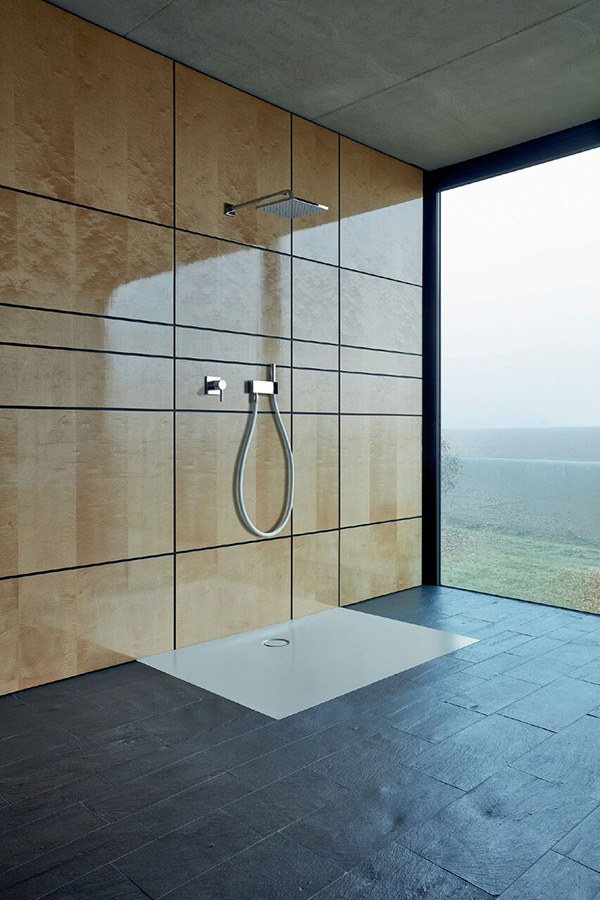
Manufactured from glazed titanium, BetteFloor from Bette is now available in 7/2 options, including a choice of 46 sizes and /2/2 matt colours. It can be ordered with Bette AntiSlip Pro, a barely visible anti-slip surface
Head of marketing at Bette Sven Resinghoff comments: “The last 1/2 months have seen a further growth in the sales of shower trays featuring anti-slip. It has taken a while for the market to build awareness of the fact that almost invisible anti-slip options exist.”
Sales and marketing director of JT John Schofield offers some detailed sales statistics, when he comments: “Anti-slip has grown 15% year-on-year to over /25% of all orders at JT”. While managing director David Osborne is even more emphatic about the popularity of anti-slip shower trays: “We have seen sales triple over the last year with anti-slip trays.”
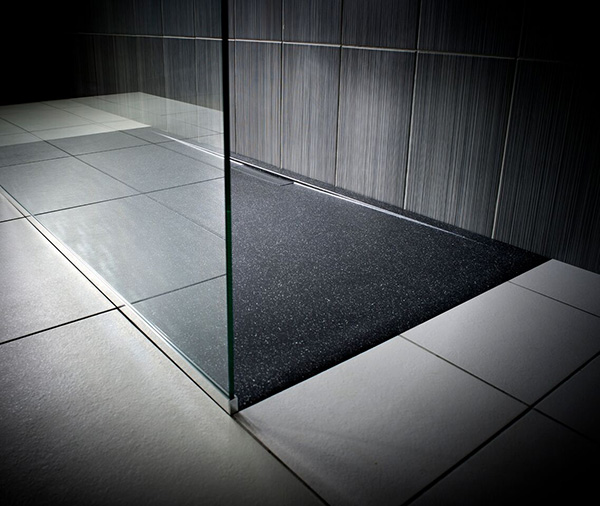
Measuring /25mm deep, the JTEvolved shower tray collection is available in 13 sizes and spans square, rectangular and quadrant options. It comes in a choice of five colours, including Astro Black, is guaranteed for /25 years and is available with optional anti-slip
The advantage for designers and specifiers is that shower trays with anti-slip also offer financial benefits. John Schofield of JT explains: “Anti-slip also offers a margin option to the trade and retailer, so anti-slip offers a welcome upsell opportunity for the bathroom industry. And even better news is there are few signs of anti-slip shower trays fading away in sales, as David Osborne of Roman exclaims they are “not so much a trend as a market development”.
Aiding inclusivity
Anti-slip shower tray sales continue to be bolstered by the demand for inclusive bathroom products to suit the needs of all users, from the youngest to the eldest generation. Unsurprisingly then, anti-slip is a popular requirement for the latest trend in low level shower trays. Deputy managing director of Mira Showers Craig Baker adds: “The ageing demographic means more people are staying in their homes for longer and require products to support their independent living, and therefore look to replace their bath with a low level shower tray. This has resulted in a surge for accessible shower trays.”
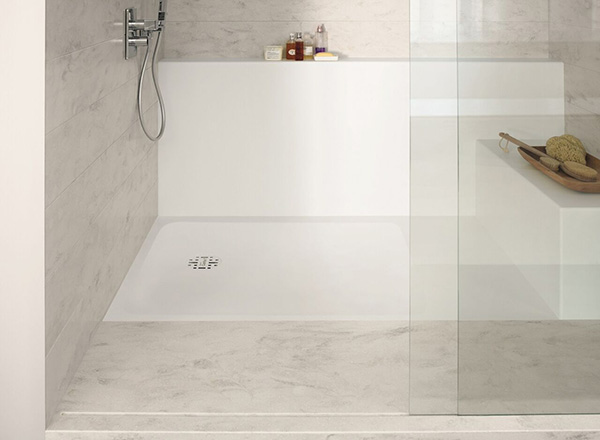
The Smart shower tray from Dupont Corian is available in sizes from 1/200mm to /2000mm, a choice of more than 100 colours and like all Corian comes with a 10-year warranty. Corian can be shaped and seamlessly joined to also create basins, vanity units and cladding for walls, showers, bath surrounds and floors
It has seen the traditional 800mm depth shower tray now almost replaced by low level options measuring 40mm. John Schofield of JT says: “Our most popular model is the JTFusion, which measures 40mm deep, and this accounts for three quarters of volume.” And 40mm depth shower trays have been further refined with even slimmer models available on the market. Merlyn offers a tray measuring /25mm, as does Frontline Bathrooms, whereas the Starck Slimline shower tray from Duravit is /20mm.

Mira Flight Low has a depth of 40mm and features BioCote technology, which is claimed to reduce mould and bacteria by up to 99%. According to the company, the tray is scratch, chip and discolouration resistant and the Mira Flight Safe additionally offers anti-slip
So it begs the question, will the 40mm shower tray ultimately give way to more slimline dimensions? John Schofield says the short answer is ‘no’, as he explains: “We have seen tray depths go from 80mm to 40mm and more lately /25mm and, with the 80mm shower trays taking less than 10% of the market share, the natural assumption is that all trays will eventually go to /25mm. However, there are two reasons why I don’t believe this will happen. Firstly, fashions change and who is to say trays won’t start to get deeper again? Design at whatever level can be very powerful and persuasive. The second reason is that a 40mm tray can be fitted flush to the floor as well as on legs, and has a shoulder, giving the consumer and the plumber confidence that the water from the increasingly high pressure showers will remain within the confines of the tray.”

Available in matt white or matt grey, Roman Showers solid surface, low profile trays have been approved for anti-slip properties. They trays come with a fast waste and there is a solid surface plinth and leg set available, if required
Buy and large
And along with the development of high pressure showers has been the requirement for more space to move in and out of the spray. As we reported last year, larger showers trays continue to grow in popularity and help future proof the home for consumers who want to ditch the tub in favour of more accessible bathing.

The Conoflat shower tray from Kaldewei features a floor level surface to create a seamless wet room look. It is available in the company’s Co-ordinated Colours Collection, including matt options such as Alpine White matt and Maple Brown Matt
Head of sales at Kaldewei Adam Teal adds: “Historically the most frequently requested tray was the 800 x 800mm square format but now 1/200 x 800mm seems to be more of the norm. Also many refurbishments now involve completely removing the bath and replacing it with a larger showering space.” Managing director of Aqata Jayne Barnes agrees, commenting: “Larger shower enclosures and trays are becoming more fashionable – our most popular sizes are 1/200mm and 1400mm wide.”
Colour and texture
With this focus on fashion and minimalist lines, it’s unsurprising that it has led to an evolution of a palette of decors and the addition of textures. Although white remains the staple choice, it has been joined by an array of pastels and muted neutrals to reflect natural materials, in matt or even stone effects.
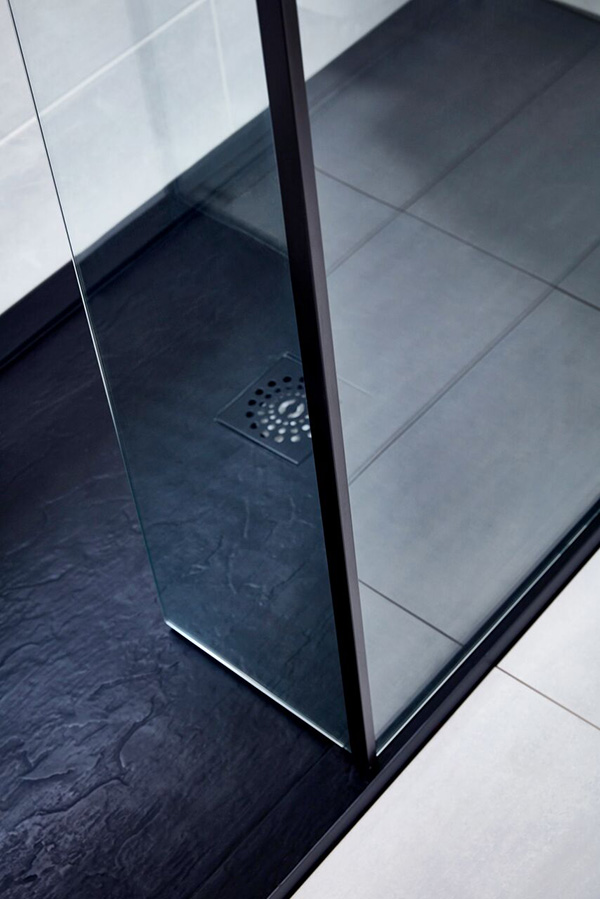
The Designer Stone Tray by Frontline features a 37mm profile and can be fitted on, or level with, the floor. It is made from stone resin, in a choice of white or black slate, and features an integrated 900mm fast flow waste
And John Schofield explains why it is important that manufacturers inject colour and texture into the market: “It is vital to offer colour options to support the trade as colour displays often attract more attention and inspire the consumer to purchase. So, while we do see colour sales growing, it will only account for 10-15% of volume of sales in the medium term.”

Offering a range of dedicated shower trays to complement its enclosures, all Aqata models are low level measuring 35mm deep. They are anti-bacterial, feature a flat rim and come with high flow waste in a chrome or gold finish
But Sven Resinghoff of Bette reports colour and matt texture trays are beginning to make headway in sales: “While white is still the most popular colour in our shower trays and floors, there has been a definite shift in the colours and finishes being chosen. Forty percent of Bette shower trays or floors are sold in matt, rather than gloss colours. Matt white is popular, and there is high demand for various shades of grey and beige. Matt colours are also getting darker with browns to dark anthracites popular.”

Made from Durasolid Q, the Stonetto tray from Duravit has a matt surface with the look and feel of stone and incorporates non-slip properties. It is available in Anthracite, Sand or White, boasts an integrated drain cover and is available in sizes up to 1600 x 1000mm
And managing director of Duravit Martin Carroll states this is also reflected in his company’s portfolio: “For shower trays we are noticing the return of colour. The matt surface of our Stonetto shower tray, for example, offers the appearance of authentic stone and is available in the shades of white, sand, anthracite and new for /2018 – concrete.”
Central to scheme
Certainly with the focus on colour and texture of shower trays, it has seen what were once commodities begin to take more prominent roles in bathroom design. Whether the tray is chosen with a colour matched waste, to blend seamlessly into the environment, or to contrast with the bathroom interior as a focal point, it is a significant element of showering area design. In fact, industry experts would suggest the tray plays an essential role in the overall scheme.
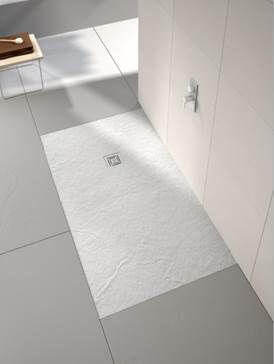
Commercial director of Merlyn Showering Barry Hoyne concludes: “It’s imperative not to overlook shower trays and to keep up-to-date with current trends. A tray is no longer purely a functional item but should be a design feature.”



